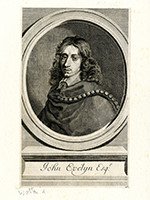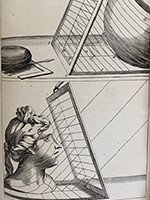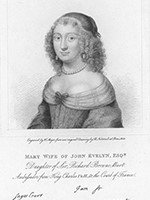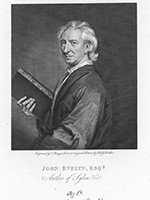 John Evelyn of Wotton and elsewhere, the diarist of 17th century life, is himself portrayed, from youth to age, in perhaps 10 portraits, over more than 60 years. One of the earliest recollections in Evelyn's 'Kalendarium' (Diary) is how, aged 5, 'my picture was drawn in oyle by one Chanterell, no ill painter (1626)'. At around 8, 'I now took an extraordinary fancy to drawing'.
John Evelyn of Wotton and elsewhere, the diarist of 17th century life, is himself portrayed, from youth to age, in perhaps 10 portraits, over more than 60 years. One of the earliest recollections in Evelyn's 'Kalendarium' (Diary) is how, aged 5, 'my picture was drawn in oyle by one Chanterell, no ill painter (1626)'. At around 8, 'I now took an extraordinary fancy to drawing'.
By 1641, both Evelyn's parents had died, and aged 20, he prepared to leave England for Europe to escape the British Civil Wars. His portraits by Hendrick van der Borcht, resident artist of his friend Thomas Howard, the 'Collector Earl of Arundel', date from this time. Evelyn's notable features of long nose and mouth are clear, although his hooded eyes are perhaps fashionably exaggerated. The original painting of 1641 was given to Evelyn's sister Jane, as a memento of the brother she might never see again. A van der Borcht showing Evelyn in armour is a curiosity, as he in fact saw no military action.
 Evelyn's next portrait was painted in 1648 by Robert Walker. Although there are no self-portraits of the diarist, he thoughtfully reviewed his own image. Walker's aquiline Cavalier youth, healthy as he still appears, here holds a skull, the classic 'memento mori' or reminder of death, while a Greek inscription above him states that wisdom is born of repentance. The words are certainly Evelyn's choice, as he remained preoccupied by a need for conscientious knowledge of the self. Evelyn had married Mary Browne in Paris the previous year, when she was 13, and made her a keepsake of the painting with its sombre message, since the couple would live apart until she was older. (Her husband at the same time sent the girl his 'Instructions Oeconomique' on how to run a household.)
Evelyn's next portrait was painted in 1648 by Robert Walker. Although there are no self-portraits of the diarist, he thoughtfully reviewed his own image. Walker's aquiline Cavalier youth, healthy as he still appears, here holds a skull, the classic 'memento mori' or reminder of death, while a Greek inscription above him states that wisdom is born of repentance. The words are certainly Evelyn's choice, as he remained preoccupied by a need for conscientious knowledge of the self. Evelyn had married Mary Browne in Paris the previous year, when she was 13, and made her a keepsake of the painting with its sombre message, since the couple would live apart until she was older. (Her husband at the same time sent the girl his 'Instructions Oeconomique' on how to run a household.)
 By 1650, Evelyn had emerged as an earnest scholar and virtuoso. He had become a collector of prints, among multitudinous interests (among them garden design, anatomy and French bread-making). The voluminous collection formed a visual encyclopaedia of his world, encompassing ancient and modern architecture, gardens, 'countries, sieges, battles…sports, executions, cavalcades…portraits of great persons, habits, machines, inventions, animals.. charts and maps'. His portrait by Robert Nanteuil is very appropriately a fine engraving. Evelyn wears a cloak elaborately edged with what are probably embroidered bullion knots, perhaps in gold or silver thread. His long dark hair is rendered lustrously waving, by the engraver's skill. Evelyn did some engraving himself, and wrote the first ever book on the art, 'Sculptura' (1662). Nanteuil's work so pleased him, a companion portrait of Mary Evelyn was also commissioned. A subsequent impression of his portrait, setting the oval above a mantel with examples of his monogrammed books, included drapery bearing some of Evelyn's motto 'seek out all, keep the best'; characteristically and perversely to this attractive image is added a Greek text 'it is better to be known for your character than your appearance'. Evelyn did in fact retain this portrait himself, both Nanteuil's original pen drawing, and the copper plate, which was for a long time at Wotton House.
By 1650, Evelyn had emerged as an earnest scholar and virtuoso. He had become a collector of prints, among multitudinous interests (among them garden design, anatomy and French bread-making). The voluminous collection formed a visual encyclopaedia of his world, encompassing ancient and modern architecture, gardens, 'countries, sieges, battles…sports, executions, cavalcades…portraits of great persons, habits, machines, inventions, animals.. charts and maps'. His portrait by Robert Nanteuil is very appropriately a fine engraving. Evelyn wears a cloak elaborately edged with what are probably embroidered bullion knots, perhaps in gold or silver thread. His long dark hair is rendered lustrously waving, by the engraver's skill. Evelyn did some engraving himself, and wrote the first ever book on the art, 'Sculptura' (1662). Nanteuil's work so pleased him, a companion portrait of Mary Evelyn was also commissioned. A subsequent impression of his portrait, setting the oval above a mantel with examples of his monogrammed books, included drapery bearing some of Evelyn's motto 'seek out all, keep the best'; characteristically and perversely to this attractive image is added a Greek text 'it is better to be known for your character than your appearance'. Evelyn did in fact retain this portrait himself, both Nanteuil's original pen drawing, and the copper plate, which was for a long time at Wotton House.
 In 1689, Godfrey Kneller, the fashionable portraitist, painted Evelyn for his friend (and fellow diarist) Samuel Pepys. The original painting has a striking simplicity. Evelyn aged 68, is unadorned, his much sparser hair now almost white. He shares the vertical space equally with his book 'Sylva or Forest Trees', by then in its third edition. Filling the left half of the image with a strong diagonal, the book makes clear its importance. 'Sylva' was the first publication of the Royal Society, founded in 1660 for the advancement of all human knowledge. Evelyn was already renowned for creating his 'paradise on Earth' garden at Sayes Court, Deptford, and for his part in Sylva, had become known as 'Sylva Evelyn'. Evelyn did not choose a text for this work, but evidently appreciated its likeness, commenting 'Nor did Kneller ever paint better and more masterly work'.
In 1689, Godfrey Kneller, the fashionable portraitist, painted Evelyn for his friend (and fellow diarist) Samuel Pepys. The original painting has a striking simplicity. Evelyn aged 68, is unadorned, his much sparser hair now almost white. He shares the vertical space equally with his book 'Sylva or Forest Trees', by then in its third edition. Filling the left half of the image with a strong diagonal, the book makes clear its importance. 'Sylva' was the first publication of the Royal Society, founded in 1660 for the advancement of all human knowledge. Evelyn was already renowned for creating his 'paradise on Earth' garden at Sayes Court, Deptford, and for his part in Sylva, had become known as 'Sylva Evelyn'. Evelyn did not choose a text for this work, but evidently appreciated its likeness, commenting 'Nor did Kneller ever paint better and more masterly work'.
During the 18th century, while his works such as 'Sylva' went into new editions, Evelyn's image itself became a desirable choice for print collectors to seek out and keep. Examples here include pieces from the 19th century collection of Robert Barclay of Dorking.
For a comprehensive account of Evelyn's portraits, visit the National Portrait Gallery website.
See also
John Evelyn (1620 to 1706) on Exploring Surrey's Past
Images
Select image to view a larger version.
- Engraved portrait of John Evelyn by Robert Nanteuil (1650) (Surrey History Centre reference PX/165/10)
- Evelyn Sculptura Diagram from Evelyn's 'Sculptura', illustrating remarks on line hatching technique for flesh and hair (2nd edition, 1755 920EVE).
- Engraved portrait of Mary Evelyn by Robert Nanteuil (Surrey History Centre reference 4348/3/22/21), from the collection of Robert Barclay
- Engraved copy of Kneller's portrait of John Evelyn (Surrey History Centre reference 4348/3/22/20), from the collection of Robert Barclay
References
Anthony Griffiths, 'John Evelyn and the Print' in 'John Evelyn and his Milieu' (British Library 2003)

